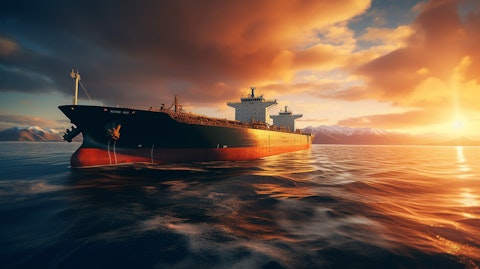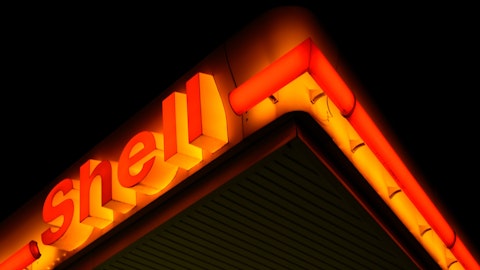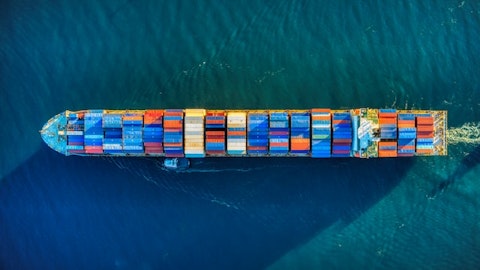Euronav NV (NYSE:EURN) Q4 2023 Earnings Call Transcript February 2, 2024
Euronav NV isn’t one of the 30 most popular stocks among hedge funds at the end of the third quarter (see the details here).
Operator: Dear all, welcome to the Euronav Q4 Earnings Call. Everyone is muted and the questions can be taken after presentation. I will now give the floor to Alexander.
Alexander Saverys: Thanks very much, Enya. Good afternoon, everyone. And welcome to our Q4 2023 earnings call. My name is Alexander Saverys, I’m the CEO of Euronav; and I’m joined by my brother, Ludovic Saverys, our CFO, and I will immediately hand the word to him.

Ludovic Saverys: Good afternoon, everybody, and thank you for dialing in on our Q4 earnings call. We’ll go through the presentation of the Q4 results, focusing on the financial highlights first and then Alexander will take over on the corporate developments and the tanker markets. And we’re extremely pleased to say that we’ve had our record Q4 in the history of the company. Since 1997, we have been able to deliver a profit for this quarter of $411 million. Obviously, that result has been skewed by capital gains out of the sales of part of the Frontline fleet of $323 million. Nevertheless, the underlying profit of $88 million puts forward a strong Q4 based on the robust freight markets. We’re happy also to include that in Q4 we’ve continued our fleet expansion within Euronav with another two VLCCs, which today still puts us with an order book of four VLCCs on order and four Suezmaxes.
The — on the right-hand side of the slide, you can see that the Q4 results were far above our P&L breakeven, but also that the Q1 guidance is going in the right direction. Alexander will continue on that. We fixed for Q1 46% at $50,430 per day for the VLCCs and on the Suezmaxes, we have 54% fixed at $55,000. If you look on the next slide, we are highlighting obviously the key metrics of our company. We still have a leverage on book equity of about 30%. Obviously, with the sale of most of the VLCCs to Frontline, we have strengthened our liquidity dramatically. End of year, we ended the year with $1.243 billion in liquidity. As of today, as most of the vessels of the CO2 Frontline have been delivered, we are close to $2.5 billion in liquidity.
The net profits of $411 million, I’ve mentioned, happy also to include that for the full year, we are at the $862 million profit, from which $490 million is coming from the business and $372 million from capital gains. Q4 has also been highlighted by a new chapter for Euronav, which Alexander will continue to explain. We have decided not to do a dividend for Q4 until the mandatory offer is over. Many of the stakeholders within Euronav, investors, analysts and others, have asked us in the last couple of weeks what the dividend policy would be for the company. Previous management and Euronav as a standalone pure-play tanker company has aimed to dividend out 80% of its net profits. Going forward, and if the transaction with CMB.TECH will be consumed next week, the Board of Directors has decided that the dividend policy will be a full discretionary one.
See also 15 Highest Quality Fast Food Burgers in the US and 35 Smartest Countries with the Highest IQ in the World.
Q&A Session
Follow Euronav Nv (NYSE:EURN)
Follow Euronav Nv (NYSE:EURN)
I think CMB.TECH shareholder has a track record of rewarding its shareholders, but in terms to give clarity to our investors, the Board of Directors will keep a full discretion on how many dividends will be paid based on the profits. The further growth, we are happy to include in the Q4 two new long-term charters to our first-year client Valero and expand our order book. As of today, within Euronav, we have a remaining CapEx of $700 million throughout the four VLCCs and more than four Suezmaxes. Again, highlighting the fact, which we mentioned in the Capital Markets Day, if the transaction with CMB.TECH would be approved next week, CMB.TECH has an outstanding capital commitment to newbuildings of $2 billion, which would bring the total CapEx commitment of $2.7 billion.
One metric we haven’t highlighted and we hope to be able to grow further in the future is the contract backlog on our Marine division. Today stands at a $1.75 billion revenue, and as CMB and Euronav have stated, it is our intention to continue to find attractive opportunities to be able to lock in long-term cash flow. Without further ado, I’ll pass on the word to Alexander on corporate development.
Alexander Saverys: Yeah. Thank you very much, Ludovic. On the corporate development, a lot has already been said over the last couple of weeks. I think if we zoom in on the Frontline transaction, I think, the first thing we can highlight today is that 23 out of the 24 VLCCs have already been delivered to Frontline. You have seen in the Q4 what the result impact is and we’ve also projected the impact of the sale of the 24 vessels or the remaining 24 vessels in Q1. One vessel still needs to be delivered, but we’re expecting that to be within Q1. We also sold the Oceania, our oldest ship in the fleet. This is also being announced today. We’re going to realize a capital gain of close to $35 million, which will be recorded in Q1 2024.
Ludovic already said, very important contract done with Valero on a long-term time charter on two new Suezmaxes for delivery in Q2 2026. Then our total order book, part of our optimization strategy, fleet renewal strategy of VLCCs at Beihai shipyard in Qingdao is now four vessels, three of them which will deliver in 2026 and one which will deliver in 2027. So if you look at our total fleet, apart from the two FSOs that we have, we have 17 Vs on the water, plus four newbuildings and 22 Suezmaxes on the water. We have the Bristol delivering very soon, plus another four on order, which are going to come in 2024 and 2026. We go to the next slide. We cannot have this call without mentioning the Red Sea. As you have heard, we were one of the very first companies to avoid the area after the Houthi rebel attacks on merchant shipping.
We have not changed our viewpoint so far, so we will continue until further notice to go and choose other routes than through the Red Sea until that situation has become safer for our crew and for our ships. The impact of the diversions can be seen every day in shipping, in general, and I would say, crude oil and product tanker shipping in specific, this indeed creating more demand for ships because of the longer ton miles and we’re expecting the situation unfortunately to last at least for the next couple of weeks, hoping for this to be resolved in the following months. We can go to the next slide. Making a little recap what we already did on the Capital Markets Day presentation of what has happened over the past months and what will happen in the next couple of weeks.
On the 9th of October we struck an agreement with the Fredriksen Group to get out of the deadlock for Euronav. That deal, that agreement was ratified in November at a special general meeting of shareholders. Just before Christmas we announced the CMB.TECH transaction and next week on Wednesday we will have a special general meeting to vote on that specific transaction. Shortly thereafter we hope to open the mandatory bid for Euronav and we hope to close it by the middle of March. I want to say a few words about the tanker markets as well. As we are in shipping there’s things we know and things we don’t know. If we zoom in on the supply side and the fleet composition, which are things that should be relatively certain, I can only say that the signals are still very positive.
If we look at the order book to fleet, even though there has been some recent increase in ordering activity specifically for Suezmaxes and some VLCC, we are still at very low order book to fleet ratios from a historical point of view, and this definitely for the next two years will be very supportive for our industry. Zooming in on the age of the vessels, stating the obvious, with a fleet that is hardly getting scrapped, the age profile of the vessels is increasing, is going up and we are now looking at ages — average ages of the fleet that we haven’t seen for a very, very long time. Again, it should be a very positive signal going forward. We have one more slide, the next slide, that zooms in on the VLCC fleet age profile and order book.



